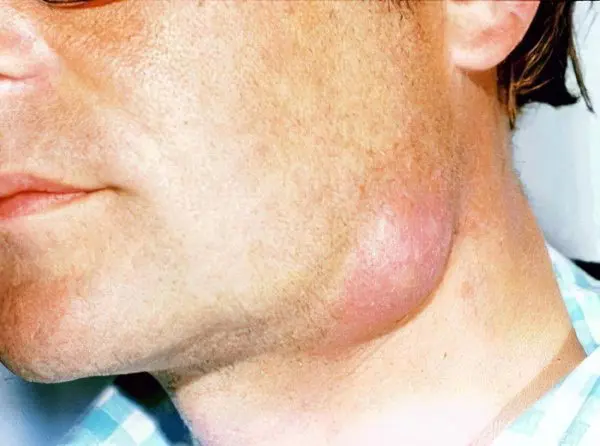
One of the most serious diseases, often leading to death, can be neck phlegmon. The defeat of soft tissues (fascia) by pyogenic microbes leads to the accumulation of pus, as well as the risk of its penetration further along the interfascial areas. Fascia is one of the subcutaneous layers covering the muscles, vessels, organs and nerves. There are several types of lesions: deep, when suppuration begins in the intermuscular tissue, and superficial, in which the upper layers are affected (subcutaneous phlegmon of the neck). Compared with abscesses, the phlegmon of the neck, which develops in the fiber, quickly captures neighboring areas, such inflammation is called spilled.
The etiology and pathogenesis of the occurrence of neck phlegmon are extensive, the cause can be both independent development (with injuries and penetration through damaged areas of pathogens), and a complication after previous diseases. Such diseases that can cause neck phlegmon include all types of tonsillitis (follicular, catarrhal, lacunar, and the like). Inflammation of the hearing organs (otitis media), dental diseases (caries, gingivitis, periodontal disease, osteomyelitis), abscess openings, lesions of the cervical spine or the back of the head can also lead to neck phlegmon.
All damage to the integrity of the skin and mucous membranes can lead to the penetration of staphylococci, streptococci, Pseudomonas aeruginosa, obligate anaerobes (clostridia, peptococci) into the fascial, connective tissue, from where the inflammation spreads to the muscles, lymph nodes and can enter the vascular system. The aggressive course of processes occurs due to the penetration of bacteria through the foci of inflammation with blood and lymph into soft tissues. With a decrease in the protective functions of the body due to the chronic course of the disease, diabetes mellitus and tuberculosis, chronic alcohol intoxication, blood diseases, immunodeficiency states, etc., the development of the disease is transient and the prognosis is most often unfavorable.
To avoid purulent complications, you should adhere to several principles: do not self-medicate diseases such as tonsillitis and abscesses that have arisen as complications of tonsillitis, carry out antibiotic therapy, strictly adhering to the prescriptions of the attending physician, diagnose throat diseases in time, thereby preventing the occurrence of neck phlegmon.
Symptoms of phlegmon neck
Along the course of phlegmon of the neck, acute and chronic stages of the course of the disease are distinguished. With small phlegmon, diagnosis is difficult due to the absence of high temperature and intoxication, as well as the inability to palpate deep subcutaneous layers with a small size of phlegmon and a large depth of its occurrence under the muscle layer of the neck. The extensive phlegmon of the neck is more pronounced, the patient feels pain on palpation, the skin is tense, redness of the skin and swelling are visually detected. Phlegmon of the neck, located on the front, in the esophagus and pharynx, causes discomfort when swallowing and breathing. The location of the focus of inflammation in the submandibular region causes pain when opening and closing the mouth and chewing movements, an unpleasant odor may appear.
The acute form of the inflammatory process leads to intoxication of the body, deterioration of blood tests, the erythrocyte sedimentation rate reaches 40–50 mm/hour.
Complications with neck phlegmon can be fatal, so timely diagnosis of the disease and immediate treatment are very important.
The chronic process shows a hard surface on palpation, when pressing on the infiltrate, the patient does not feel pain, the temperature is normal.
List of complications in neck phlegmon: sepsis, abscesses, meningitis – from a diseased organ through the blood, asphyxia – when crushed by a purulent sac of the respiratory tract, bleeding – from ruptured vessels with purulent masses, penetration of pus into hollow organs.
In addition to the above complications, the process can move to bone tissue, tendons and muscles. The risk of death with neck phlegmon increases due to the anatomical structure, the presence of large blood arteries, and proximity to the brain. Unrecognized inflammation in time leads to the spread of toxins and enzymes that destroy tissues throughout the body. Diagnosis of deep-seated inflammation is carried out by excluding tuberculous streaks, malignant tumors and lymphogranulomatosis. The final diagnosis is made after a history of previous diseases that could cause the appearance of neck phlegmon.
Treatment of phlegmon of the neck
A detailed blood test that determines the causative agent of the disease, and testing for sensitivity to antibiotics will help prescribe the correct etiotropic therapy. Fulfilling all the recommendations of the doctor and observing the medicinal prescriptions, you can count on a favorable outcome of the disease, hospitalization is desirable. In case of detection of phlegmon of the neck, surgery is most often recommended. Preventive recommendations include advice to carefully monitor the condition of the oral cavity, throat and treat inflammation of the gums in time.










